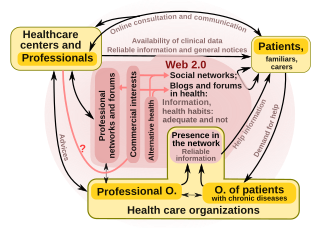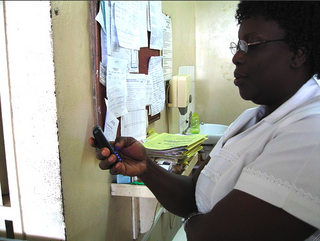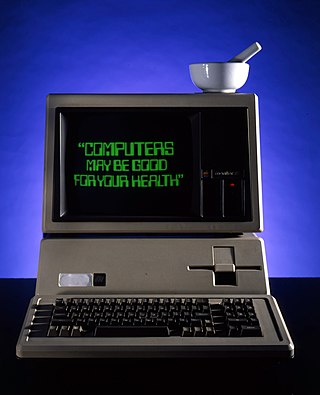Group psychotherapy or group therapy is a form of psychotherapy in which one or more therapists treat a small group of clients together as a group. The term can legitimately refer to any form of psychotherapy when delivered in a group format, including art therapy, cognitive behavioral therapy or interpersonal therapy, but it is usually applied to psychodynamic group therapy where the group context and group process is explicitly utilized as a mechanism of change by developing, exploring and examining interpersonal relationships within the group.

Health On the Net Foundation (HON) was a Swiss not-for-profit organization based in Geneva which promoted a code of conduct for websites providing health information and offered certificates to those in compliance.
eHealth describes healthcare services which are supported by digital processes, communication or technology such as electronic prescribing, Telehealth, or Electronic Health Records (EHRs). The use of electronic processes in healthcare dated back to at least the 1990s. Usage of the term varies as it covers not just "Internet medicine" as it was conceived during that time, but also "virtually everything related to computers and medicine". A study in 2005 found 51 unique definitions. Some argue that it is interchangeable with health informatics with a broad definition covering electronic/digital processes in health while others use it in the narrower sense of healthcare practice using the Internet. It can also include health applications and links on mobile phones, referred to as mHealth or m-Health. Key components of eHealth include electronic health records (EHRs), telemedicine, health information exchange, mobile health applications, wearable devices, and online health information. These technologies enable healthcare providers, patients, and other stakeholders to access, manage, and exchange health information more effectively, leading to improved communication, decision-making, and overall healthcare outcomes.
Self-diagnosis is the process of diagnosing, or identifying, medical conditions in oneself. It may be assisted by medical dictionaries, books, resources on the Internet, past personal experiences, or recognizing symptoms or medical signs of a condition that a family member previously had or currently has.
An e-patient is a health consumer who participates fully in their own medical care, primarily by gathering information about medical conditions that impact them and their families, using the Internet and other digital tools. The term encompasses those who seek guidance for their own ailments, and the friends and family members who research on their behalf. E-patients report two effects of their health research: "better health information and services, and different, but not always better, relationships with their doctors."
The Journal of Medical Internet Research is a peer-reviewed open-access medical journal established in 1999 covering eHealth and "healthcare in the Internet age". The editors-in-chief are Gunther Eysenbach and Rita Kukafka. The publisher is JMIR Publications.
Online health communities are online social networks related to health. They primarily provide a means for patients and their families to learn about illnesses, to seek and offer social support, and to connect with others in similar circumstances. These online groups can be composed of individuals with illnesses, groups of medical professionals with shared interests, non-professional caregivers and family of patients, or a combination. The term "online health community" is primarily academic jargon.

"Health 2.0" is a term introduced in the mid-2000s, as the subset of health care technologies mirroring the wider Web 2.0 movement. It has been defined variously as including social media, user-generated content, and cloud-based and mobile technologies. Some Health 2.0 proponents see these technologies as empowering patients to have greater control over their own health care and diminishing medical paternalism. Critics of the technologies have expressed concerns about possible misinformation and violations of patient privacy.

PatientsLikeMe (PLM) is an integrated community, health management, and real-world data platform. The platform currently has over 830,000 members who are dealing with more than 2,900 conditions, such as ALS, MS, and epilepsy. Data generated by patients themselves are collected and quantified with the goal of providing an environment for peer support and learning. These data capture the influences of different lifestyle choices, socio-demographics, conditions and treatments on a person's health.

mHealth is an abbreviation for mobile health, a term used for the practice of medicine and public health supported by mobile devices. The term is most commonly used in reference to using mobile communication devices, such as mobile phones, tablet computers and personal digital assistants (PDAs), and wearable devices such as smart watches, for health services, information, and data collection. The mHealth field has emerged as a sub-segment of eHealth, the use of information and communication technology (ICT), such as computers, mobile phones, communications satellite, patient monitors, etc., for health services and information. mHealth applications include the use of mobile devices in collecting community and clinical health data, delivery/sharing of healthcare information for practitioners, researchers and patients, real-time monitoring of patient vital signs, the direct provision of care as well as training and collaboration of health workers.
The use of electronic and communication technologies as a therapeutic aid to healthcare practices is commonly referred to as telemedicine or eHealth. The use of such technologies as a supplement to mainstream therapies for mental disorders is an emerging mental health treatment field which, it is argued, could improve the accessibility, effectiveness and affordability of mental health care. Mental health technologies used by professionals as an adjunct to mainstream clinical practices include email, SMS, virtual reality, computer programs, blogs, social networks, the telephone, video conferencing, computer games, instant messaging and podcasts.
Health blogs are niche blogs that cover health topics, events and/or related content of the health industry and the general community.

An activity tracker involves the practice of measuring and collecting data on an individual's physical and psychological activity to keep track and maintain documentation regarding their health and wellness. Used for many groups even animals as seen in collar-mounted activity trackers for dogs. A lot of the data is collected through wearable technology such as wristbands which sync with mobile apps through Apple and Samsung. As daily technologies such as phones and computers have been innovated, it paved the way for such wearable tracking technologies to be advanced. There are a variety of stakeholders involved in the usage of activity tracking through wearable technology and mobile health apps, knowing how much they track ranging from fitness, mood, sleep, water intake, medicine usage, sexual activity, menstruation, and potential diseases raises the concern on privacy given a lot of data is collected and analyzed. Through many studies that have been reviewed, data on the various demographics and goals these technologies are used provide more insight into their purposes.

Health information on the Internet refers to all health-related information communicated through or available on the Internet.
Infodemiology was defined by Gunther Eysenbach in the early 2000s as information epidemiology. It is an area of science research focused on scanning the internet for user-contributed health-related content, with the ultimate goal of improving public health. Later, it is also defined as the science of mitigating public health problems resulting from an infodemic.
Psych Central is a mental health information and news website. Psych Central is overseen by mental health professionals who create and oversee all the content published on the site. The site was created in 1995. The site was named as one of the Internet's 50 Best Websites in 2008 by Time, and has approximately 6 million unique visitors per month. PsychCentral was acquired by Healthline in August 2020. Former attorney and author, Faye McCray was appointed Editor-In-Chief in 2021.
Digital therapeutics, a subset of digital health, are evidence-based therapeutic interventions driven by high quality software programs to prevent, manage, or treat a medical disorder or disease. Digital therapeutic companies should publish trial results inclusive of clinically meaningful outcomes in peer-reviewed journals. The treatment relies on behavioral and lifestyle changes usually spurred by a collection of digital impetuses. Because of the digital nature of the methodology, data can be collected and analyzed as both a progress report and a preventative measure. Treatments are being developed for the prevention and management of a wide variety of diseases and conditions, including type 1 & type II diabetes, congestive heart failure, obesity, Alzheimer's disease, dementia, asthma, substance abuse, ADHD, hypertension, anxiety, depression, and several others. Digital therapeutics often employ strategies rooted in cognitive behavioral therapy.
Digital phenotyping is a multidisciplinary field of science, first defined in a May 2016 paper in JMIR Mental Health authored by John Torous, Mathew V Kiang, Jeanette Lorme, and Jukka-Pekka Onnela as the "moment-by-moment quantification of the individual-level human phenotype in situ using data from personal digital devices." The data can be divided into two subgroups, called active data and passive data, where the former refers to data that requires active input from the users to be generated, whereas passive data, such as sensor data and phone usage patterns, are collected without requiring any active participation from the user.
Mobile ethnography is a qualitative research method that takes advantage of technology to document, analyze and derive implications of real-time customer experience. Therefore it’s often applied in the context of service design. Unlike classic ethnography where a researcher has to be present for observations, mobile ethnography uses the participant’s mobile device to gather user-centered information. It allows the participant to become an active researcher him- or herself, report experiences at the time of the happening, on the very spot and in the mental space of the experience and structure it themselves. Mobile ethnography therefore follows the principles of user-centered design.

Internet-based treatments for trauma survivors is a growing class of online treatments that allow for an individual who has experienced trauma to seek and receive treatment without needing to attend psychotherapy in person. The progressive movement to online resources and the need for more accessible mental health services has given rise to the creation of online-based interventions aimed to help those who have experienced traumatic events. Cognitive behavioral therapy (CBT) has shown to be particularly effective in the treatment of trauma-related disorders and adapting CBT to an online format has been shown to be as effective as in-person CBT in the treatment of trauma. Due to its positive outcomes, CBT-based internet treatment options for trauma survivors has been an expanding field in both research and clinical settings.







